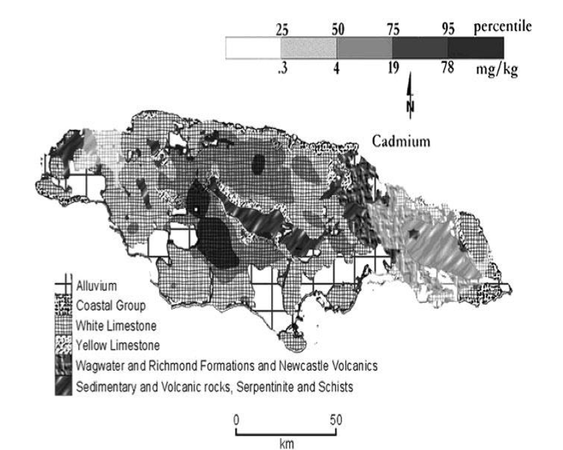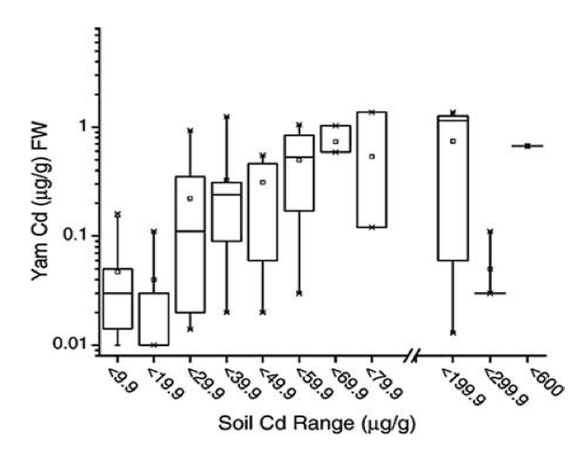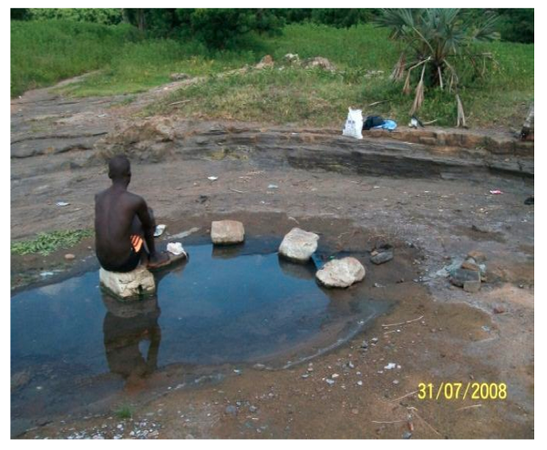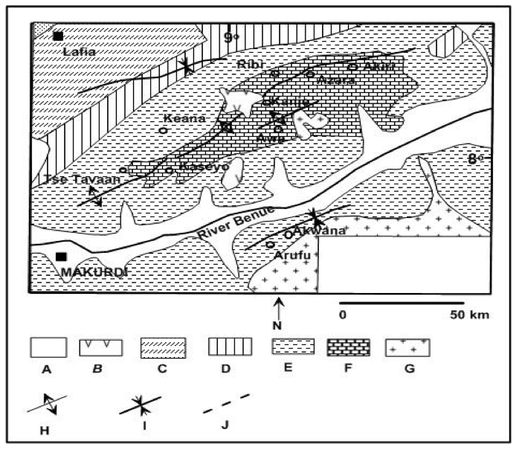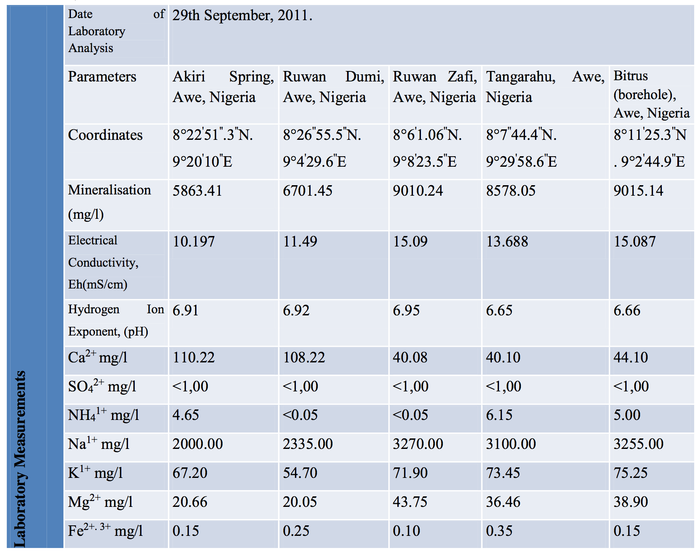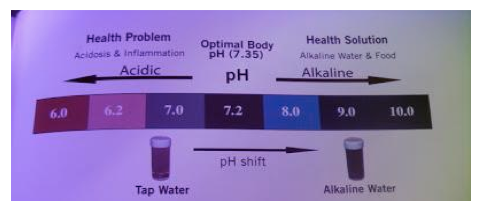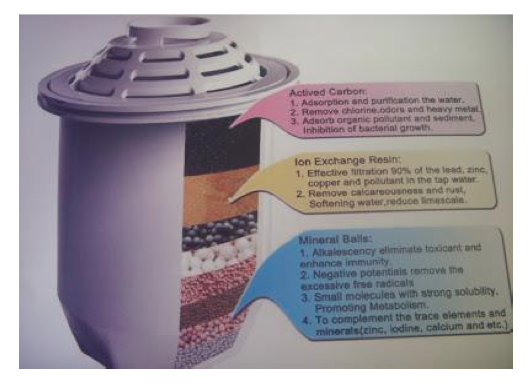Difference between revisions of "Medical geology"
Justgerrardz (talk | contribs) |
Cwhitehurst (talk | contribs) |
||
| Line 539: | Line 539: | ||
==References== | ==References== | ||
| + | {{reflist}} | ||
| + | |||
| + | ==Other Resources== | ||
* [http://www.medicaljobsaustralia.com/ Medical Jobs Australia] | * [http://www.medicaljobsaustralia.com/ Medical Jobs Australia] | ||
| − | * [http://www.medicaljobsaustralia.com/jobs/australia/nurses-and-midwives/ Nursing Jobs] | + | * [http://www.medicaljobsaustralia.com/jobs/australia/nurses-and-midwives/ Nursing Jobs] |
| − | |||
| − | |||
| − | |||
Revision as of 18:09, 8 April 2019
| Wiki Write-Off Entry | |
|---|---|

| |
| Student Chapter | University of Nigeria, Nsukka |
| Competition | June 2015 |
Medical Geology is a multi-disciplinary field of study in geology which studies the health effects of geologic materials and processes on humans. Such health effects can be good, or possibly hazardous. Medical Geology integrates professionals from medicine, geography and geology to handle problems accruing from the geology of an area. Three aspects of geology are relevant for a comprehensive study of health problems arising from the geology of a particular environment, namely: mineralogy, geochemistry and hydrogeology. Hazardous effects are caused by the excessiveness or deficiency of essential and non- essential trace elements such as: As, F-, I- , Se, Rn, Mn, Cd and Pb. For instance, excessiveness of arsenic in coals in China has lead to a toxic effect called arsenosis– the ulceration of the hands and feet; deficiency of iodine in the soil leads to goiter –the enlargement of the thyroid gland, while the excessiveness of fluoride in rocks leading to various forms of fluorosis which can manifest in the dissolution of apatite crystals of the enamel. This multidisciplinary field of geology also probes into the benefits and banes of eating soil, clay and shale –a practice called geophagy. Through the study of Medical Geology, however, some geologic materials have been found useful in the pharmaceutical, medical and cosmetic industries. These include medicinal/mineralized waters applied in the treatment of various skin diseases, such as rashes and eczema, as they contain elements such as Na, Ca, Mg, Cl, K, I, Br and Fe. Bathing in such mineralized waters―a process called balneotherapy―helps in taking these elements into the body through osmosis. Alkaline water production using tourmaline (Ca, K, Na)(Al, Fe, Li, Mg, Mn)3(Al, Cr, Fe, V)6(BO3)3(Si, Al, B)6O18(OH, F)4, and zeolite (Na2Al2Si3O10.2H2O ) is another important application of Medical Geology. Alkaline water negates the Oxidation-Reduction Potential of body toxins and increases the body pH up to 8. As most processed foodstuffs are acidic, the intake of alkaline water will raise the alkalinity of the body leading to increased longevity. Kaolin and bentonite-–the healing clays–-are applied in the treatment of gastrointestinal diseases; they have net negative surface charges with which they attract toxins. Toxins are then adsorbed into the structure of the clay mineral, and thus removed. Medical Geology also has important application in the manufacture of plaster of Paris. It is produced by calcining gypsum to produce a strong material used in holding fractured anatomical structures of the body in place until healing is completed. Production of milk of magnesia from brucite [Mg(OH)2]―magnesium hydroxide―is another important application of Medical Geology. Milk of magnesia is an antacid and interferes with the adsorption of folic acid in the stomach; it helps in maintaining the stomach pH and in the detoxification of the stomach.
Introduction to medical geology[edit]
Rocks are the fundamental building blocks of the Earth’s surface, containing a multitude of minerals and chemical elements. These rocks are broken down by weathering processes which restructure the minerals to form the soils on which crops and animals are raised.[1] Through the consumption of plants and animals− i.e. the food chain− man comes in contact with those elements originally in the rocks. Should the rock/soil be deficient in a particular element such as iodine, the effect would manifest as adverse health effects on the consumers. On the other hand, if there is excess concentration of a particular element such as arsenic in the rock/soil, the health of the consumer is equally at risk.[2]
The intake of contaminated groundwater exposes the consumer to the risk of injecting harmful elements into the body system. Groundwater is made available to man as springs, rivers, lakes and through man-made wells.
Volcanism is another geologic process that poses potential harm to human health, ejecting tons of different poisonous gases and volcanic ash. These travel kilometers round the planet to be inhaled by people at different radii from the vent thereby causing diverse toxicity problems in the victims.[3]
In addition, dust from deserts is a source of health hazard to man. The harmattan season for example, comes with moments of increased asthma torments and various sorts of nasal difficulties such as catarrh as it has the potential to transport soil pathogens to distant regions. It has been confirmed that dust from the Sahara travels across the Mediterranean Sea to the hinterlands of Europe and to North America.[4]
Medical geology, therefore, is a developing multidisciplinary collaboration that curtails the health effects arising from the various geologic materials and processes of an area, because the environment in which man lives affects the health of man.[4]
However, the above-mentioned issues are not the total range of medical geology. It is also interested in the use of geologic materials to cure various kinds of diseases. This has led to researches into the use of clay minerals for therapeutic purposes. It has also launched profound research into the use of mineralized thermal waters for the treatment of various diseases. These efforts have yielded laudable results over many decades. Most prominent of its efforts is the introduction of iodized salt in most countries for the prevention of goiter[5]
Medical geology achieves these goals through a coordinated effort by various professionals from geology, geography, biochemistry and medical sciences.
In essence, medical geology is a multidisciplinary field of study in geology which studies the health effects of geological materials and processes on humans and animals with both good and, possibly, hazardous results. The Commission on Geological Sciences for Environmental Planning defines medical geology as, "the science dealing with the influence of ordinary environmental factors on the geographical distribution of health problems in man and animals." The goal of this field is to find the right balance and intake of elements/minerals in order to improve and maintain health[6]
According to Finkelman et al,[6] the range and scope of medical geology include:
- Identifying and characterizing natural sources of harmful materials in the environment using geosciences techniques;
- The study of trace elements, especially their bioavailability;
- Establishing a baseline or background levels of contaminants, potentially harmful but naturally occurring materials in water, soil, air, food and animal tissue;
- Learning how to predict the movement and alteration of chemical, infectious and other disease-causing agents;
- Understanding how people may be exposed to such materials; and
- Investigating the health benefits of geologic materials and processes.
Multidisciplinary nature of medical geology[edit]
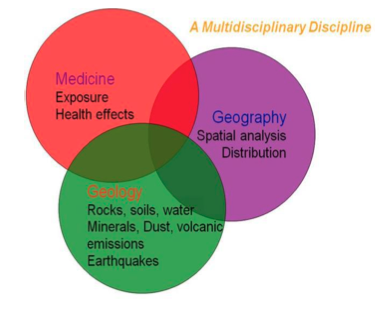
Due to the complexity of health problems arising from the geology, medical geology uses a multidisciplinary approach in its operations: it integrates experts from geology, geography, biochemistry and medical sciences who work as a team to tackle health problems (Figure 1).
Geographical approaches are employed to ascertain the total number of individuals affected by an epidemic through the use of spatial analysis. On the other hand, biochemical studies provide an insight into the processes that elements undergo in biochemical systems while the burden of studying the epidemiological and toxicological aspects of diseases lies on the shoulders of medical sciences. Through such approaches, medical doctors are able to cure such diseases.[7]
Furthermore, geology is employed as a tool in identifying the causative element(s)/mineral(s) of the epidemic. This is achieved through desk study and field work aimed at identifying the host rock or soil and to map its lateral extent. Water sources such as lakes, rivers, streams and man- made wells are not left out in such studies. Mines, quarries and ore processing sites are all brought under the surveillance of geologists. This is achieved through a comprehensive mix of three aspects of geology: geochemistry, mineralogy and hydrogeology.
Geochemistry is the study of the chemical changes in the earth. More specifically, it is the study of the absolute and relative abundances of chemical elements in minerals, soils, ores, rocks, water and atmosphere of the earth and the distribution of and movement of these elements from one place to another as a result of their chemical and physical characteristics. This approach is used extensively in the search for the causative element of a particular epidemic.
Mineralogy is a subject of geology specializing in the scientific study of the chemistry, crystal structure and optical properties of minerals.
Simply put, hydrogeology is the aspect of geology that studies the interaction between geologic materials and groundwater; because, as ground water passes through geologic media, it takes up some of the elements either in suspension or in solution. Consumption of such contaminated water sources can be ‘grave’. Thus, hydrogeology is important in gaining useful understanding of the water quality of a region/locality.
Environment and our health[edit]
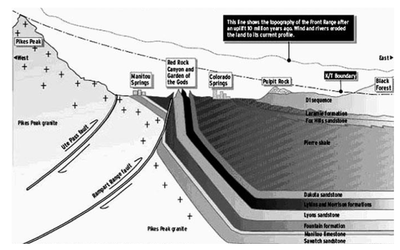
Over the years, it has been observed that the environment man lives in affects his health. For instance, the people of Maputaland, South Africa, are plagued by nutrient-poor soil. Maize grown in this region has very low content of elements such as calcium, potassium and phosphorous.[9] This is as a result of low concentration of these elements in the rocks of that region. Countries in southern Africa also suffer from selenium deficiency in their soils. This accounts for the spread of HIV-1 virus in this zone as selenium which inhibits the replication of HIV-1 is lacking in their soil. Still in Africa, Kerala Province in Uganda is another region under the “hammer” of geology. Children in this province suffer from a ‘grave’ coronary heart condition called endomyocardial fibrosis (EMF). This epidemic is attributed to the deliberate eating of soil containing the element cerium.[10]
China is not left aside in these problems. The country suffers from deficiencies and excessiveness of selenium in many parts of the country resulting in life-threatening health problems. China also suffers from the influx of arsenic into coal deposits whose domestic use has resulted to untold chronic health effects over the years.[3]
The use of water from the Colorado Springs at the Pikes Peak in the Rocky Mountain region of USA had led to dental fluorosis amongst children. This condition arose as a result of meteoric waters that flowed over faulted granitic batholiths.[8] The meteoric waters ‘picked up’ fluoride from easily dissolved minerals at the fault and incorporated it into the flow. Fluoride was also injected into the Colorado Springs by fluoride-enriched fractured and faulted Cretaceous Pierre Shale that underlies the spring (Figure 2).
Biological classification of elements[edit]
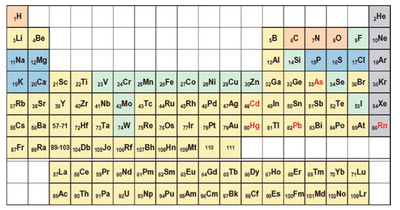
Good understanding of health issues arising from geologic materials comes from sound knowledge of the classification of elements from the biological point of view because not all elements have been proven to cause health problems. Therefore, medical geology is mainly geared towards identifying and understanding the harmful elements.[7]
Naturally occurring elements are classified into major elements, minor elements, trace elements and noble gases (Figure 3).
According to Nordberg, and Cherian[11] major elements are those elements that are needed in large quantities in the body; each makes more than 1% of the human body (oxygen alone making up to 65% of the body). They include hydrogen, oxygen, carbon and nitrogen. These elements form most of the DNA structures in the human body; they occur in most organs and tissues. In addition, they are the main building blocks of enzymes; they are also important constituents of the cell membrane, inter-cellular, intracellular fluids and are actively involved in metabolic processes, all in their ionic states. Hence, in the event of high intake of these elements, the body has many ‘sites’ where they can be used. Nature provides a good abundance of these elements as it has been observed that the concentration of these elements is fairly the same in similar rocks and show the least variance compared to the minor and trace elements. Thus, they rarely pose problems.[7]
Minor elements are those elements that are needed in moderate quantities; each has a concentration of 0.1% to 1.0% in the body.[7] They share in the functions of the major elements, but in smaller amounts.
Trace elements are those elements that have concentrations far below 0.1% in the body; they are needed in the body only in parts per million (ppm). They are essential to plant and animal lives only in trace amounts. Such trace elements are called essential trace elements.[12] They are highly variable in their abundance in various rocks (Table 1).
| Element | Ultrabasic Rock | Basalt | Granite | Shale | Limestone |
|---|---|---|---|---|---|
| As | 1 | 2 | 1.5 | 15 | 2.5 |
| Cd | - | 0.2 | 0.2 | 0.2 | 0.1 |
| Co | 150 | 50 | 1 | 20 | 4 |
| Cr | 2000 | 200 | 4 | 100 | 10 |
| Cu | 10 | 100 | 10 | 50 | 15 |
| Pb | 0.1 | 15 | 20 | 20 | 8 |
| Se | - | 0.05 | 0.05 | 0.6 | 0.08 |
| U | 0.001 | 0.6 | 4.8 | 4 | 2 |
| W | 0.5 | 1 | 2 | 2 | 0.5 |
| Zn | 50 | 100 | 40 | 100 | 25 |
Deficiency of these elements in the soil results in their low abundance in plants. Sequel to this, plants –as primary producers –would decline in supplying them to animals and humans– the consumers. Deficiency of these nutrients brings negative health effects to humans and animals. A typical example is iodine deficiency which leads to goiter, which is caused by ‘shortage’ of iodine in the rocks. On the other hand, over-abundance of any of these elements causes toxicity problems (Table 2). For instance, excess arsenic is known to cause lesion of the skin in some Asian countries such as Bangladesh and China.[5]
| Element | Deficiency | Excessiveness/Toxicity |
|---|---|---|
| Iron | Anemia | Haemochromatosis |
| Copper | Sway Back | Chronic Copper Poisoning |
| Zinc | Dwarfism | Diarrhea |
| Cobalt | White Liver Disease | Heart Failure |
| Magnesium | Convulsion, Malformation of the Skeleton | Ataxia |
| Chromium | Disturbances in Glucose Metabolism | Kidney Damage (Nephritis) |
| Selenium | Liver Nechrosis | Hyperkeratosis |
However, some trace elements such as As, Cd, Pb, Hg and Rn have no/limited biological functions and are generally toxic to humans; they are called non-essential trace elements.[7]
From the above biological classification of elements, it can be seen why medical geology sets its eyes on the trace elements: they are the causes of most health problems sourced from geologic materials. They emanate from igneous, sedimentary or metamorphic rocks, as well as industrial minerals. They contaminate groundwater through boreholes or through springs/streams. In addition, they can be released during volcanic eruptions.
Geochemobiological Pathways[edit]
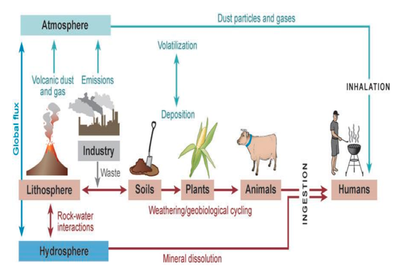
This is the rock-soil-plant-animal/human pathway, and it is of major importance in the study of medical geology. It describes the various ways through which people can come in contact with elements originally in the rocks, (Figure 4).
Elements are released from rocks through weathering− the process by which rocks are broken down into smaller components.
Physical weathering is the process by which rocks are broken down into smaller chunks without altering its mineral content. It occurs through temperature changes and by the action of the wind. Temperature variation leads to the development of flakes on the rocks whose removal exposes subsequent layers to further heating and cooling and, then, to chemical weathering. Physical disintegration of rocks is also caused by the action of burrowing animals and plant roots. Freezing of water in crevices of rocks is another force that disintegrates rocks making them prone to chemical weathering.[14]
Chemical weathering describes the process that alters the chemistry of minerals. It can proceed through hydration, hydrolysis, oxidation, reduction and dissolution. Chemical weathering is fuelled by water and weak soil acids.[7]
In addition to these, there are processes that make the various elements available to plants: sorption and desorption. According to Selinus et al,[7] sorption is the retention of metal ions on the surfaces of soil particles through mutual attraction between oppositely charged particles. Desorption refers to the release of these metal ions for plant use as a result of alterations in pH and redox conditions. By consuming plants and animals raised on such soils, man comes in contact with the elements originally in the rocks.
Another pathway through which humans come in contact with the earth’s elements is by water intake whether from man-made wells, rivers, streams or lakes.[3] These emanate from groundwater which might have leached both toxic and non-toxic elements from rocks through which it flowed.
Inhalation of volcanic gases and dust from deserts, un-tarred roads, mines and volcanic emanations form another important pathway of exposure to dangerous elements. Volcanism is the principal process that brings elements to the surface from deep within the earth. The volcanic eruption of Mount Pinatubo is a splendid example of the dramatic effects of geology. During just two days in June ,1991, Mount Pinatubo, Philippines ejected 10 billion metric tonnes of magma and 20 million tonnes of SO2 for over 15,000 meters high into the atmosphere; the resulting aerosols influenced global climate for three years. This single event introduced an estimated 800,000 tonnes of zinc, 600,000 tonnes of copper, 550,000 tonnes of chromium, 100,000 tonnes of lead, 1000 tonnes of cadmium, 10,000 tonnes of arsenic, 800 tonnes of mercury, and 30,000 tonnes of nickel to the surface environment (Garrett, 2000).
Health issues arising from selected elements and geological materials and processes[edit]
Many health problems exist in many parts of the world due to the over-abundance or deficiency of trace elements in the environment and as a result of many geologic processes that go on in such regions. These include: excessiveness of arsenic in drinking water, excessiveness of fluoride in drinking water, deficiency of iodine leading to Iodine Deficiency Disorders (IDD) amongst others. These are discussed in this section.
Excessiveness of Arsenic (As)[edit]
Geochemistry of Arsenic: Arsenic is a metalloid and has high affinity for sulphide-bearing minerals. One of such minerals is pyrite, hence the formation of arsenopyrite (FeAsS). In the tropics, oxidative weathering leads to the formation Arsenite (As3+) and Arsenate (As4+).[15]
Mechanism of Toxicity: Due to its affinity for sulphur, arsenic in biological systems, attacks sulphur-bearing enzymes by binding and blocking them. Soon, it makes its way through the digestive tract to the liver, spleen and lungs. Although most arsenic is excreted, some are still retained in the skin, hair, legs, nails and teeth.[16] As the concentration increases, adverse health effects result leading to carcinogenic or non-cancer problems. Prolonged exposure to arsenic induces peripheral arteriosclerosis, hair fall-out, retarded nail growth and various types of skin conditions such as hyperkeratosis, hyper- pigmentation and skin malignancies. These levels of disorders are prominent in places with arsenic concentrations of 100−1000μg/l in their groundwater as against 50μg/l stipulated by WHO in 1993.[17] However, the presence of selenium reduces the toxic effects of arsenic.
In Nigeria, high concentrations of arsenic have been confirmed in the Northern Benue Trough in the Kaltungo area of Gombe State. Arsenic in this area emanates from coarse porphyritic granite, biotite granite, Bima Sandstone and basalt.[15] Arsenic was determined using Inductively Coupled Plasma Optical Emission Spectrophotometer (ICPOES), Optima 2000 DV, at the Petroleum Technology Development Fund (PTDF) Geochemistry Laboratory of Department of Geology and Mining, University of Jos. The arsenic concentrations tend to follow the same northeast- southwest trend as the Benue Trough. High concentration of arsenic in this area is attributed to the mid-Santonian magmatism in the Benue Trough.[15]
Arsenic, in this area, is released into the groundwater and surface water through dissolution, weathering and erosion of the host rocks. Being an anion, it sticks to mineral surfaces especially iron from biotite.[15] This explains the mobility of iron and arsenic during weathering and deposition in the area.
Results show that the concentration of arsenic in all the rock types at Kaltungo and the environs is far above the average crustal abundance of 2 ppm. Generally, the concentration ranges from 152.900 ppm to 235.200 ppm in the coarse porphyritic granite; it varies from 232.200 ppm to 243.100 ppm in the biotite granite. In the Bima Sandstone, the concentration ranges from 228.700 ppm to 87.540 ppm while in the basalts of the area, the range is from 174.600 ppm to 151.600 ppm.[15]
Health impacts of excessive arsenic in groundwater in Zimbabwe[edit]
Most parts of the African Precambrian Complex such as the Greenstone Belts have been subjected to metallic sulphide mineralization.[10] This led to the introduction of arsenic into aquifers in many parts of Africa. Within these regions, the sulphide-loving arsenic has been introduced into the environment as a result of gold mining in Ghana and South Africa, metal sulphide mining in Zimbabwe and South Africa and coal mining in South Africa.
At Iron Duke Mine, near Mazowe, Zimbabwe, acid mine drainage (AMD) having a pH of 0.52 was encountered.[10] This was observed during a research into the geochemistry of the mine waters of Harare, Midlands and Shamva Greenstone Belts. The mine waters from Iron Duke Mine, near Mazowe has arsenic concentration of about 72mg/l− the highest dissolved arsenic concentration on earth.[10]
Arsenosis in China[edit]

Arsenosis refers to a range of adverse health effects caused by the intake of arsenic into the body system above the recommended values of 50μg/l.
In Guizhou Province, China, the cool, damp autumn weather forces villagers to bring their harvest of chili peppers and corn indoors to dry. They hang the peppers over unvented stoves which were formally fueled by wood. But, due to the destruction of forests, wood became scarce; so, the villagers turned to the plentiful outcrops of coal for heating, cooking and drying their harvests.[16] Unknowingly to them, mineralizing solutions in this area had deposited enormous concentrations of arsenic − up to 35,000 ppm − and other trace elements on the coals. It should be noted that normal coals have arsenic concentration of 20 ppm. Consumption of the chili peppers dried over these arsenic-rich coals exposed the natives to arsenosis. The dried chili peppers contained up to 500 ppm of arsenic whereas normal chili peppers contain less than 1 ppm of arsenic.[18] In addition, inhalation of arsenic-laden indoor air derived from coal combustion has increased the toll of arsenic poisoning in the region.[6]
Chemical and mineralogical tests conducted showed that there were many arsenic-bearing minerals in the coals, although, much of the arsenic is bound to the organic matrix of the coals. This observation presented two problems namely: (1) since arsenic is bound to the organic matrix, conventional reduction methods of removing arsenic was ineffective; (2) the visually observable pyrite on the coal samples was not reliable in establishing arsenic-rich samples.
This caused an outbreak of various kinds of arsenosis resulting from arsenic poisoning with typical symptoms as shown in the Table 3 below and Figure 5.[17]
| Organ Affected | Effects |
|---|---|
| Cardiovascular System | Peripheral vascular disturbances leading to gangrene |
| Nervous System | Peripheral neuropathy and hearing defects |
| Skin | Hyperpigmentation, Hyperkeratosis and Skin tumors |
| Haematopoietic System | Disturbed erythropoiesis with anaemia |
| Liver | Liver dysfunction, Haemangioendothelioma |
To help solve this problem, villagers were supplied with field test kits to ascertain the arsenic content of coals in the field before use in their unvented stoves. Thus, chili peppers dried over the unvented stoves were free from arsenic contamination.
Arsenosis is also reported in Inner Mongolia Autonomous Region of China. It is caused by the contamination of surface and groundwater resources by arsenic derived from high- arsenic minerals. Chifeng City in Kosk Teng County in eastern Inner Mongolia is the most affected in this region. It is located on the slope of a mountain with arsenopyrite deposits. The weathering of arsenopyrite (FeAsS) deposits releases arsenic into the groundwater and surface water bodies. The groundwater was delivered to the surface through springs and wells. Out of 34 wells investigated, arsenic concentration between 0.16 mg/l to 0.45 mg/l was observed by Selinus et al.[14] 22 persons out of 45 persons tested positive to minor arsenosis.[14]
Water purification technologies to remove arsenic from water[edit]
Arsenic removal from water can be carried out in different ways. To do this, it is important to distinguish between different types of arsenic as different methods are applied for each of the types: organic or inorganic. Groundwater mainly contains inorganic arsenic such as the arsenides and the arsenates. Proven methods include ion exchange, membrane filtration and iron and aluminum coagulation. Buffering methods have also shown great success in removing arsenic from mine waters.[10] In addition, sequential extraction speciation studies and geochemical modeling methods have shown great potential for removing arsenic from mine waters through the use of hydrous ferric oxides to precipitate arsenic at wide pH ranges. Arsenic removal from soils can be achieved by the use of ferns that bio-accumulate large arsenic concentrations.[10]
Iodine Deficiency Disorders (IDD)[edit]

Iodine is very important for the proper functioning of the human body. In all mammals, it is needed for the efficient functioning of the adult in trace amounts in the order of 0.0004 wt%.[10] This quantity is maintained as a result of small intake of iodine from drinking water and various forms of foodstuffs throughout the lifetime of the mammal.
Iodine is released into the environment through volcanic emanations. It is incorporated in sea salt and occurs in formation waters and fluid inclusions. The highest iodine concentration, however, is found in sea water; thus coastal soils are more iodine-enriched than mainland soils.[10]
As an evidence, traverses of the Moroccan coast show that the expanse of land, 100–200 km away from the coast shows stronger iodine enrichment than inland areas.[10] Highlands prevent the transport of iodine inland; this explains the decline in iodine concentration in the continental interiors of Africa, especially in mountainous areas of East Africa. However, volcanic mountains are usually rich in iodine; but leaching in the lee sides of high-altitude areas has caused acute depletion of the iodine content of soils. This is pronounced in the Kerio District in the Kenyan Rift Valley which has high prevalence of goiter and other related conditions collectively known as Iodine Deficiency Disorders, IDD.[10]
Iodine Deficiency Disorders (IDD) includes goiter (enlargement of the thyroid gland), cretinism (mental retardation with physical deformities), reduced IQ, miscarriages and birth defects.[10] Although IDD has been recognized as a serious problem in several areas in Africa, Kerio District ranks first, with 72% of children in this region living with goiter.[10]
To curtail IDD, salt iodization programme has been introduced, not only in this region but in all African countries. However, this project has not yielded maximum results due to the counteracting effect of goitrogens in the African diet. Goitrogenic effect comes from certain vegetables such as brassica. It proceeds by depressing the formation of thyroid hormone leading to increased secretion of thyroid stimulating hormone (TSH). The thyroid gland responds to this by enlarging itself as a compensating mechanism leading to the development of goiter (Figure 6).[10] Another substance with goitrogenous effect is thiocyanate which is present in cassava consumed in many African countries. It inhibits the entrance of iodine into the thyroid gland.[10]
In China, about 425 million people are at risk of IDD. In iodine deficiency areas, a serious shortage of iodine intake by pregnant women would affect the development of the nervous system of the fetus and newborn infants would likely suffer from cretinism and related health problems.[20] Endemic cretinism prevailed in Chinese regions with acute iodine shortage. Analysis showed that places with iodine threshold of 25μg suffer from endemic cretinism whereas places with only goiter usually have iodine threshold of 50 μg. This triggered off a research into the relationship between goiter and cretinism in 25 provinces on 750,000 persons. The research showed that goiter had an average prevalence rate of 24.92% while cretinism had an average prevalence rate of 3.15% (Zheng et al, 2010). Fortunately, inhalation of iodine volatized from coal has contributed to increased reduction in the goiter cases.
Health effects resulting from the deficiency and excessiveness of selenium[edit]
According to Fordyce,[21] selenium is found in phosphatic rocks, coals, organic-rich shales and sulphide mineralization. It occurs in the soil in the form of selenites (Se4+), selenates (Se6+), selenides (Se2-) and elemental selenium (Se0).
It can accumulate in the kidneys, liver, marrow, myocardium, pancreas, lungs, skin and hair. [21]
Deficiency of selenium manifests as a disease known as Keshan disease– a disease that occurs due to the deterioration of the heart muscle leading to chronic cardiomyopathy. Generally, WHO (1987, 1996) recommended a daily Se intake of 30 μg of selenium for females and 40 μg of selenium for males. Excess concentration of Se in the body results in garlic scent from the mouth and skin (due to the formation of dimethyl selenide), hair loss, nail fragility, edema of the lungs, malfunctioning of the liver, redness of the skin, rhinitis and bronchoalveolitis.[21]
In living systems, selenium occurs as selenocysteine and is incorporated in two enzymes, namely: glutathione peroxidase and 1 5'-iodothyronine deiodinase. These enzymes are important in the thyroid gland where they help in thyroid hormone production. Glutathione peroxidase protects cells against oxidative damage by acting as a catalyst in the breakdown of hydrogen peroxide. According to Davies[10] thyroxine is broken down to triiodothyronine–an important thyroid hormone– through deiodination catalysis by iodothyronine deiodinase. These hormones –triiodothyronine and thyroxine– contain iodine. So selenium and iodine are involved in the formation of thyroid hormone. It follows, therefore, that combined iodine and selenium deficiencies affect the metabolism of thyroid hormone leading to increased rate of IDD. This explains the reason for the severity of IDD in Central Africa and Democratic Republic of Congo as both countries have low concentrations of selenium and iodine in their soils.
Health benefits of selenium[edit]
The selenium-containing protein, glutathione peroxidase, competes for the human body system with HIV-1 and thus stops its replication in the body. However, according to Davies,[10] there is a particular selenium level in the body above which HIV-1 infection cannot occur. Below this level, the human body gets infected by HIV-1. The deficiency of selenium in the soil of southern African countries is the cause of high scourge of HIV-1. Selenium supplementation programmes would help in tackling this menace.
Selenium has other health benefits as follows:
- It is an anti-cancer: it detoxifies cancer-causing agents and stops tumour in blood vessels;
- It fights against heart diseases and diabetes: it reduces inflammation and cholesterol build-up and is important in lipid peroxidation; it reduces the risk of homocysteine and regulates blood pressure;
- It boots immunity by stimulating neutrophils, B cells, T cells, NK cells and macrophages;
- It decreases the ageing process by maintaining the length of telomere and by reducing the oxidative stress of the mitochondria;
- It reduces the risk of asthma, arthritis and muscular dystrophy as a result of the anti-oxidative nature of selenoenzymes; and
- Trivializes the effects of depression and anxiety.[7]
Toxicity effects of excess fluoride[edit]
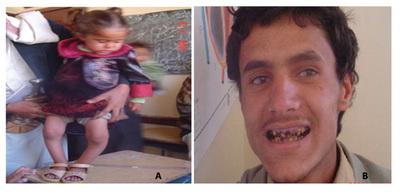
With an electronegative value of 4.0, fluorine is the most reactive element on earth. It has very low dissociation energy. This means that it has the tendency to accept electrons from other elements, and has the greatest ease to form strong bonds. The fluoride ion has an ionic radius of 1.33 Ȧ and an ionic charge of -1; this is similar to that of the hydroxyl ion which has ionic charge of -1 and ionic radius of 1.32 Ȧ[22]
Fluoride (F-), the ionic form of fluorine, can stimulate bone formation and it also has been demonstrated to reduce dental caries at doses of at least 0.7 mg/l in drinking water.[7] Concentration in the excess of this figure leads to adverse health effects called fluorosis (Table 4). Dental fluorosis occurs when the fluoride ions continually substitute for hydroxyl ions in the apatite [Ca10 (PO4)6(OH, F, Cl, Br)2] crystals of the enamel. The enamel loses its glittering appearance as chalky white patches develop; this is called mottled enamel.[22] Dental fluorosis proceeds to change the colour of the teeth from chalky white to yellow, brown or black. Finally, the yellow, brown or black patches become dissolved (Figure 7).
| Concentration of Fluoride (mg/l) | Possible Health Effects |
|---|---|
| Less than 0.5 | Possibility of dental cavities |
| 0.5–1.5 | Normal concentration |
| Greater than 1.5 | Possibility of mottling of teeth and dental fluorosis |
| Greater than 3 | Occurrence of skeletal fluorosis (e.g. osteoarthritis, Figure 7) |
Geologic materials that are characteristically rich in fluorine are organic clays and shales, carbonatites, phosphates, hydrothermal ores and silicic igneous rocks such as rhyolites, dacites and granites.[14]
Studies have shown that fluoride mineralization occurs in tectonically unstable areas such as zones of rifting and zones characterized by rise of fluoride from the lower crust or upper mantle. This explains why people living in the African Rift zones and volcanic areas have high concentration of fluoride in their natural water bodies. In the East African Rift, in particular, most of the lakes are contaminated by fluoride as a result of influx of fluoride from hot springs and volcanic gases.[10] The lake with the highest fluoride concentration occurs in this area−Lake Nakuru in the Kenyan Rift Valley. According to Davies,[10] the water of this lake has fluoride concentration in the order of 2800 mg/l. Other African countries with high fluoride concentration in groundwater include granitic areas in Ghana and parts of Malawi and Tanzania while sedimentary areas with high fluoride concentration are found in parts of North Africa and Senegal in West Africa.[10] Nigeria, Zimbabwe and Ethiopia had been hit by adverse health conditions triggered by nutritional fluoride imbalance.[10]
Health effects of Cadmium, Cd[edit]
Figure 8 Distribution of Cadmium in the central districts of Jamaica[23]
Figure 9 Correlation between yam Cd concentration and soil Cd concentration.[23]
Cadmium has great affinity for sulphides and is therefore associated with sulphide deposits. It has very similar tetrahedral covalent radius to that of zinc; thus, it can displace zinc from sphalerite (ZnS).
Cadmium is highly toxic to humans. According to Hutton,[17] it mainly accumulates in soft tissues such as the kidneys and liver. In Japan, it is the cause of a disease known as itai-itai–a disease that affects mainly women.[24] Its symptoms include: backaches, pain in the limbs, arthralgia and pain in the pubic bones. This is the direct result of the loss of calcium in bones. The loss makes the bones to be fragile and causes the development of fractures. The victim remains in pain until death. In a particular autopsy conducted, 72 fracture points were seen.[24]
Health issues arising from high cadmium concentration has also been established in the central parts of Jamaica (Figure 8). It occurs in the soil of a region with limestone and an overlying aluminum-rich bauxite deposit.[23] Cadmium exists in a phosphatic band that forms the interface between the two lithologies. Further research indicates that the phosphatic band contains fossilized fish bones and teeth suggesting a marine origin. The processes of weathering release cadmium from the phosphatic band into the soil.
This has drastically increased the cadmium level in Jamaican soil to maximum values of 900 mg/kg against cadmium levels in other parts of the world which range from 0.1 mg/kg to 0.5 mk/kg.[23]
The cadmium storage ability varies greatly in the various parts of plants, namely: the fruit, roots and the leaf as shown by tests conducted on food crops root crops, legumes and vegetables (Table 5).
| Food Category | Number of Samples | Range (Conc. in mg/kg) |
|---|---|---|
| Fruit | 18 | 0.005-0.14 |
| Legumes | 4 | 0.026-0.132 |
| Vegetable: leaf | 12 | 0.02-1.71 |
| Vegetable: root | 9 | 0.43-0.94 |
| Other Root Crops | 35 | 0.026-1.04 |
| Food Category | Types of Samples |
|---|---|
| Fruit | Ackee, banana, breadfruit, corn, cucumber, orange, ortanique, plantain, tomato, pumpkin, squash, sweet pepper, zucchini |
| Legumes | Cow peas, French bean (string bean), gungo peas, red kidney beans |
| Vegetables: leaf | Broccoli, cabbage, callaloo, cauliflower, lettuce, pak choi, thyme |
| Vegetables: root | Beet, carrot, onion, turnip |
| Other root crops | Cassava, coco, dasheen, ginger, potato, sweet potato, yam |
Amongst the above plant species, yam and carrot show the greatest ability to store cadmium. The concentration of cadmium in yam increases as the soil Cd level increases; it, however, decreases at low levels indicating toxicity as shown in Figure 9.
Toxicity effects of cadmium occurred in Jamaica as a result of food intake from Cd- contaminated food crops, legumes and vegetables. The mean Cd intake was 9.3 μg/kg bodyweight/week above WHO guideline of 7 μg/kg bodyweight/week while the drinking water standard for cadmium is 5μg l-1 .[23]
Health effects of radon gas[edit]
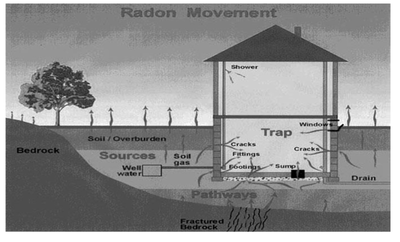
Radon is a colourless inert gas formed from the radioactive disintegration of radium –the radioactive daughter of uranium. It has been established that there is a link between the levels of radon emitted by the rocks and that emitted by soils. The level of radon emitted by any rock depends on the quantity of uranium it contains which occurs in association with other minerals such as gold, phosphate and copper. This explains the scourge of lung cancer amongst uranium miners, as radon is carcinogenic. Radon emitted from most rocks travel to the surface through fractures and faults.[8] Its movement into buildings occurs through foundation cracks, cracks in the floor and walls below and above the surface. It can also enter through gaps in timber floors and around pipe fittings (Figure 10).
African countries that have uranium as a natural resource include: South Africa which has the largest deposit of uranium in the continent–241,000 metric tons, Niger, Namibia, Gabon, Algeria, Botswana, Central African Republic, Chad. Others are: Egypt, Nigeria, Morocco, Mali, Madagascar, Malawi, Togo, Tanzania, Mauritania, Somalia, Guinea, Zambia and Lesotho.[10]
Health effects of geogenic dust[edit]
This refers to various kinds of dust that humans are exposed to, both in the working place and at home. These include dust from deserts and unpaved roads, silica from mines and quarries and asbestos from mines and industrial plants.
Health impacts of harmattan dust[edit]
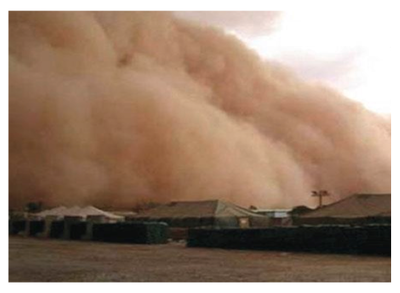
In Nigeria, the most important source of dust is the Sahara Desert. Its influence arrives in Nigeria in the form of harmattan mainly in the months of December, January and February. Harmattan wind transports very fine particulate matter which may be toxic inorganic or organic particles and/or pathogens (Figure 11). This triggers or strengthens respiratory problems such as asthma and catarrh.
Another important source of dust in Nigeria is unpaved roads. The passage of traffic cause particulate matter to rise from roads causing untold damage to people’s respiratory systems.
The health effect of the dust depends on the size: the bigger particles affect the airways and lungs while fine particles go farther to affect parts of the alveolar. In addition, the composition of the dust goes a long way to determine the possible health effect; it can be organic or inorganic. Organic dust contains particles of animal, vegetable and those of microbial origin such as bacteria and fungi.[14] This type of dust causes allergic aveolitis. Organic dust may contain minerals such as quartz, feldspar and mica produced as a result of the abrasion action of the wind. These can get dissolved in the blood stream causing damage in the kidney, brain and other organs. Generally, the composition is dependent on the type of rock from which the dust was derived.
Health effects of asbestos[edit]
Asbestos is an industrial term that comprises six different natural fibrous silicates. They include: grunerite, (Fe, Mg)7 Si8O22(OH)2, riebeckite, Na2(Fe,Mg)3Fe2Si8O22(OH)2, tremolite, Ca2Mg5Si8O22(OH)2, anthophyllite, (Mg, Fe)7Si8O22(OH)2 and actinolite, Ca2(Fe, Mg)5Si8O22(OH)2 all belonging to the amphibole group while the sixth mineral, chrysotile, Mg6(Si4O10)(OH)8 is a serpentine.[25] These minerals can exist together as a homogenous mineral deposit or in combination with other minerals. Asbestos have found diverse applications owing to its flexibility, high tensile strength and resistance to heat, chemicals, and electricity. Thus, they are used in the manufacture of pipe lagging, asbestos roofing sheets, clutches and brake linings and insulation materials.[25]
Notwithstanding their many applications, they are extremely dangerous to human health. Because of their fibrous structure, asbestos can penetrate deep into the lungs when inhaled causing different forms of damage to the affected tissues. This disease is known as asbestosis–a fatal lung disease that saps the patient of strength. Such inhalation can also lead to lung cancer, cancer of the gastrointestinal tract and pleural mesothelioma.[14]
The toxicity of asbestos is determined by three factors: fiber dimension, bio-persistence and dosage. Fiber dimension refers to the relationship between fiber length and diameter; this decides where the asbestos would be deposited in the lung. With regard to fiber dimension, lung cancer has primarily been associated with fibers which are greater than 10 μm in length and greater than 0.15 μm in diameter; mesothelioma is associated with fibers which are greater than 5 μm in length and less than 0.1 μm in diameter while fibrosis has been associated with particles >5 μm in length.[7]
Bio-persistence of asbestos is influenced by the rate and site of deposition; high rate of deposition can overwhelm macrophages and thus lead to toxicity effects. Other bio- persistence factors are rate of clearance, solubility, rate and pattern of breakage and ease of translocation across membranes.
Amphibole asbestos minerals are needle-like straight and long fibers and the main cause of mesothelioma diseases. Grunerite and riebeckite are the most dangerous of all the amphiboles and can remain in the lungs for long periods of time, counting in decades. This has informed the banning of asbestos in various regions of the world. However, despite all eye-opening researches done on the subject, asbestos mining and use still flourish in the African continent and many other developing countries. In Africa, South Africa is the giant in amphibole asbestos mining, depending heavily on grunerite and riebeckite. These occur in the metamorphosed Precambrian sedimentary strata (banded ironstone) in the Transvaal Super Group. Most of the asbestos mined are used in the production of cement pipe.
Health effects of silica[edit]
Silica is an important component of diatomites–a resource mined and produced in Kenya, Ethiopia, Algeria and South Africa.[10] It is used in the manufacture of fillers, filters and may be used in making mild abrasives.
Silica dust can be inhaled at quarries and at diatomite mines. It is most dangerous at the stage of calcining resulting to silicosis. It also affects people that live near the mine and processing plants. Worst of all, silicosis is contagious. In addition, its deposition in the lung is proven to cause fatal lung cancer.[7]
However, not all forms of silica cause silicosis. The dangerous types are the crystalline forms –quartz, chrystobalite and tridymite. They cause illnesses such as nodular pulmonary fibrosis (also known as silicosis), lung cancer, bronchitis and secondary heart diseases.[7]
Geophagy[edit]
Geophagy refers to the deliberate consumption of soil, clays and shale in some cultures. The practice is most common amongst the female folk especially during pregnancy. They say it is beneficial for the development of the fetus and helps to overcome anxiety and agitation.[7] However, the practice is not limited to women– men and children practice geophagy. Reasons abound why people eat clays, shales and soils.
Shale and clay as food and food detoxifier[edit]
Many African tribes eat clay as a source of food. It is intended to create a sensation of ‘fullness’ in the stomach. It is done as part of the menu in most cases. Geophagy is also practiced in times of famine. At such times, most people depend heavily on the eating of clay, shale or soil for survival as food supply dwindles, as a result of flood, drought or war. In South America, the Ottomac tribe resorts to the eating of soil when their local supply of fish and turtles declines during a time of annual flooding. The soil was prepared from alluvial sand molded into 12.5 cm–15 cm diameter balls.[7] Food shortage has also been reported as the cause of geophagy in Malawi.[7]
In addition, shale, clays and soils are used as food detoxifiers. This is practiced mostly during times of famine to detoxify toxic food items from plant origin before consumption. Clay is used in this regard because of its cation exchange capacity so that potentially harmful chemicals get adsorbed into the clay structure making the food item harmless. This is practiced by some African tribes who use clay to detoxify wild yam, Dioscorea dumentorum, during famine. The use of clays and soil to detoxify wild plant foodstuffs is not restricted to Africans alone, the Aymara and Quechua people who live on the Andes of Bolivia and Peru consume wild potatoes by dipping them in clay slurry. The clay slurry effectively removes potentially toxic glycoalkaloids and, thus, renders it harmless to the natives.[7]
Geophagy for pharmaceutical reasons[edit]
From ancient times, soils and clays had been used as pharmaceuticals by humans for the treatment of various diseases. Such practices still persist in the modern world. In Europe, the various varieties of the soil, terra sigillata, have been used for over 2,000 years for the treatment of a number of health problems such as bites and stings of venomous animals, malignant ulcers, nose bleeds, gout, dysentery and poisoning.[7] The effectiveness of terra sigillata is attributed to the ion exchange capacity of the soil. As a result, bentonite– enriched in the clay mineral montmorillonite– is extensively used in the developed nations as an antidote to poisons. Also, kaolin is used in the treatment of gastrointestinal disorders such as gastrodynia (stomachache), dyspepsia (acid indigestion), nausea and diarrhea.
In Nigeria, 400–500 tonnes of Paleocene shale collected from the village of Uzalla situated in Orhionmw, Edo State is used for the treatment of dysenteric ailments; this is called eko by the villagers.[7]
Geophagy for cultural reasons[edit]
In some African cultures, clays and soils are eaten so as to reaffirm the eaters’ bond with the ancestors, blood, grave and fertility.[10] This practice is common amongst the Luo tribe of western Kenya where women of reproductive age eat soil to ‘improve fertility’. Here soil from termite moulds is preferred because of its red colour which represents blood. In this tribe, boys stop eating soil just to ‘become men.’
Nutritional reasons for indulging in geophagy[edit]
Laboratory analyses have been used to authenticate the assumption by local geophagist that clays, shales and soils supply nutrients. For instance, the ability of clays to supply nutrients is dependent on the cation exchange capability of the clays. In the stomach, the ingested clay in contact with the acidity of the stomach releases elements such as calcium and iron through cation exchange reactions. As a result, pregnant women consume clays and shales to improve on their daily calcium levels needed for the fetal skeletal growth and development. According to Selinus et al,[7] during the first trimester of pregnancy, ingested clays absorb dietary toxins which are harmful to the embryo and help to reduce the common symptoms of pregnancy sickness. In the second trimester of pregnancy, ingested clays help to reduce pregnancy-induced hypertension. The daily calcium level increases from 800 to 1,200 mg day-1.[7]
Results for analyses conducted on various samples of geophagical materials obtained from several countries are shown in the Table 6.
| Date of Study and Origin of Sample | Calcium | Copper | Iron | Potassium | Magnesium | Manganese | Sodium | Zinc |
|---|---|---|---|---|---|---|---|---|
| 1966, Nigeriaa | 3,910 | - | - | 53 | 2,005 | - | 44 | - |
| 1971, Ghana | 120 | - | - | 165 | 31 | - | - | - |
| 1973, Ghanab | 1,133 | 10 | 95 | 130 | 331 | <1 | - | 15 |
| 1984, Nigeriac | 265 | 0.6 | 134 | 41 | 179 | 29 | - | 30 |
| 1991, Cameroon | 77 | - | 9 | 45 | - | - | - | - |
| 1991, Gabon | 68 | - | 4 | 87 | - | - | - | - |
| 1991, Kenya 1 | 791 | 2 | 7 | 432 | 35 | 163 | – | 3 |
| 1991, Kenya 2 | 220 | 1 | 12 | 793 | 113 | 349 | - | 5 |
| 1991, Nigeria | 19 | 2 | 10 | 102 | 9 | nd | - | 3 |
| 1991, Togo | 120 | - | 5 | 177 | - | - | - | - |
| 1991, Zambiad | 142 | 11 | 74 | 93 | 60 | 19 | - | 2 |
| 1997, Ugandae | 1,341 | 2.1 | 528 | 763 | 458 | 59 | 186 | 6.7 |
nd =not detected;
a = Mean of two samples collected from soil pits that are utilized by the Tiv tribe;
b = Median concentrations determined from 12 samples;
c = Eko clay;
d = Sample from the Kalambo Falls archaeological site;
e = Median concentrations determined from 12 samples used as traditional medicines;
Dangers of Geophagy[edit]
Despite the various benefits of geophagy, it can be detrimental to human health. The cation exchange capacity and the adsorption potential of clay and shale can lead to the deficiency of certain elements in the body. For instance, in Turkey, iron-deficiency anemia has been linked to the consumption of clays especially sepiolite and montmorillonite of high capillary electrochromatography.[26] This is caused by the effectiveness of clays to adsorb iron. In addition, the consumption of clay has been confirmed to cause potassium deficiency–a condition known as hypokalemia. It is reflected by low concentration of potassium in the blood. In a situation whereby there is concurrent deficiency of iron and potassium, a disease known as cachexia Africana results. This can, however, be treated by iron and potassium supplementation programmes.
In Turkey, the consumption of soil by women and children has been noted to cause the combined deficiency of iron and zinc.[26] According to a research conducted, deficiency of zinc leads to growth retardation and delayed puberty. Thus, for persons that have low concentration of zinc in the blood, geophagy helps to further lower the level of zinc in the blood. However, zinc supplementation programmes have been supremely effective in improving growth and normal puberty maturation in this region.
In an environment where the soil is contaminated with lead, geophagy could expose little children to lead poisoning. This could lead to damage to the developing brain and nervous system. Lead is particularly dangerous to young children as research has shown that there is no safe level for lead in children.
Additionally, consumption of biological components of soils such as eggs and larvae of bacteria and fungi can lead to various kinds of diseases. For instance, ascariasis and trichuriasis are caused by the ingestion of Ascaris lumbricoides and Trichuris trichiura eggs respectively. Toxocariasis occurs through infection with the larvae of Toxocara canis or T. cati. Furthermore, hookworm is consumed through oral intake of Ancylostoma duodenale and A. ceylanicum.[7]
Therapeutic applications of medical geology[edit]
From ancient times, man has explored geologic materials and put them to use for his well- being. Some of them had been used domestically while others have many industrial, as well as medical applications, depending on available technology.
Therapeutic application of medical geology refers to the use of geological materials in the treatment of diseases. Nigeria has a lot of potentials for the therapeutic applications of geologic materials. For instance, the country is blessed with thermal mineralized waters in various parts of the nation such as the Ikogosi Warm Spring in Ekiti State, the mineralized thermal springs at Awe in Nasarawa State and those in the onshore/offshore locations of Delta, Rivers, Cross Rivers, Edo, Bayelsa and Imo States. In addition, Nigeria is blessed with abundance of medicinal clays such as kaolin and bentonite in most states of the federation. Also, there is abundance of peat, trona and potash in some states (after Nghargbu et al, 2013[27][28]).
Sadly, lack of technological know-how and fewer number of medical geology practitioners in Nigeria have limited the extraction of these resources for medical purposes.
A plunge into this untapped area has the potential to boost healthcare delivery in Nigeria while at the same time providing employment opportunities for many. The development of medical geology in Nigeria will undoubtedly boost the GDP of the country.
Mineral/Medicinal waters at Awe, Nigeria[edit]
There are five thermal mineralized springs at Awe, Nasarawa State. They include: Bitrus– a borehole, Tangarahu (Figure 12), Ruwan Zafi, Ruwan Dumi and Ruwan Zafi Akiri, all located in the Central Benue Trough of Nigeria (Figure 13).
The water of these springs is connate in nature; it was formed as a result of the trapping of ancient sea water in the Cretaceous host-beds of sandstone, silt and shale at Awe. They have high concentrations of sodium and chloride together with other cations and anions namely, thus they are termed chlorosodic. They form important sources of salt for the local community. The mineralization value of these springs is in the excess of 1000 mg/l; hence, their use for the treatment of orthopedic, dermatological, gynecological and respiratory tract diseases. According to Nghargbu et al,[27][28] these springs have temperatures ranging from 32.9 –46.5°C (Table 7). This unique temperature range makes the waters of these springs good for the treatment of circulatory and vascular ailments. They are also needed in the treatment of vasodilation and inflammation.
Based on consistent similarities observed from laboratory analyses, the Awe springs can be grouped into two namely: Ruwan Akiri, Ruwan Dumi and Tangarahu (Group 1) and Ruwan Zafi and Bitrus (Group 2).
Group 1 springs are low mineralization waters containing mainly sodium chloride with chlorosodic values of 0.58%, 0.67% and 0.86%, respectively.[27][28] They also contain iodine, calcium and magnesium. Group 2 springs are isotonic and have higher concentration of calcium and magnesium; they have chlorosodic value of 0.9%. With these qualities, they are good for medical treatment and prophylaxis.[27][28]
Therapeutic action of the mineralized thermal springs[edit]
The Group1 springs are applied in balneotherapy– the act of treating diseases by taking bath in mineralized water. During the bath (Figure 14), sodium chloride gets into the keratose layer of the epidermise through osmosis. The bath can be done in basins or bath tubes.
However, to achieve maximum results, the bath is combined with physical exercise; this method is called balneokinezytherapy. This combined action can be applied in the treatment of the following diseases:
- Orthopaedic injuries,
- Arterial high blood pressure in 1st and 2nd period of the disease,
- Poor circulation of blood in lower limbs caused either by diabetes or sclerosis,
- Polineuropathy,
- Pareses and atrophy of muscles,
- Skin diseases: psoriases and allergies and
- Psychosomatic diseases.[27][28]
However, balneokinezytherapy should not be applied under the under-listed conditions:
- Non-stable coronary disease,
- Early period after heart failure,
- Cancer,
- Active tuberculosis and
- Pregnancy.[27][28]
Mineralized water from these springs can be used in shower baths in which the water is pressurized into a jet of water. This can be applied in the treatment of: high arterial blood pressure, nervous over-excitability and flabbiness of skin.
Another form of application is in balneological inhalations in which the mineralized water is dispersed in a carrier to form an aerosol. According to Nghargbu et al,[27][28] inhalation of the aerosol is used in clearing the respiratory tract and in the treatment of sore throat, chronic inflammation of the trachea (tracheitis) and chronic inflammation of the bronchia (bronchitis).
Furthermore, these springs are applied in krenotherapy– treatment of diseases by drinking saline water. This is used in the treatment of chronic inflammation and subacidity of stomach, heavy metal poisoning and constipation. Additionally, saline water can be used in flushing the mouth to remove bacteria and secretions. However, krenotherapy should not be used on a patient with poor blood circulation, poor performance of kidney, active ulcer of stomach, diarrhoea and ulcer of duodenum.[27][28]
Conversely, the Group 2 springs are isotonic and compatible with the osmotic pressure of the human blood. They are used the same way as the Group 1 springs although their action is mild.[27][28]
Bentonite[edit]
Bentonite is an absorbent aluminum phylosilicate rock containing mostly montmorillonite. It is formed mainly from volcanic ash. The name comes from the largest known deposit of bentonite clay located in Fort Benton, Wyoming, USA. It is a unique clay due to its ability to produce electronegative charge when hydrated giving it the ability to attract and neutralize toxins which are electropositive. When mixed with water, bentonite rapidly swells open like a highly porous sponge, making the toxins and heavy metal to be drawn in through electrical attraction without leaching away any of its beneficial elements. This phenomenon prevents toxic molecules from passing through the walls of the intestines and entering the bloodstream; instead, they are eliminated from the body through the kidneys.
Based on the above properties, bentonite is an important healing clay. It can be applied on the skin to remove eczema and also applied on the face (Figure 15) and other parts of the body as a cream where it leaves the skin smooth and radiant.[29]
Kaolin[edit]
Kaolin is made up of the clay mineral, kaolinite with the chemical composition Al2Si2O5(OH)4. Kaolinite is a layered silicate mineral, with one tetrahedral sheet linked through oxygen atoms to one octahedral sheet of alumina octahedra. It is also known as China clay. Kaolinite has low shrink-swell capacity and low cation exchange capacity.[7] It is a soft, earthy, usually white mineral produced by the chemical weathering of aluminosilicate minerals such as feldspars. In many parts of the world, it is colored pink, orange or red by iron oxide, giving it a distinct rust hue. Lighter concentrations yield white, yellow or light orange colours.[7]
Kaolin is used for the treatment of mild-to-moderate diarrhoea, dysentery and cholera. It is also used in combination products for the treatment of inflammation and soreness of the mouth. Such products are also used for the treatment of ulcers and inflammation of the large intestine.[27][28]
Milk of Magnesia[edit]
Milk of magnesia is a name given to magnesium hydroxide – an inorganic compound with the formula, “Mg(OH)2”. It forms a milk-like appearance when in suspension, hence the name. The solid mineral form of magnesium hydroxide is brucite [Mg(OH)2] which occurs in clay minerals especially in chlorite. Brucite occupies the interlayer position which is normally occupied by monovalent and divalent cations such as Na+, K+, Mg+ and Ca+ in chlorite. In this manner, chlorite interlayer is cemented by brucite and can neither swell nor shrink.[30]
Milk of magnesia is used as an antacid to neutralize stomach acid. Hydroxide ions from the Mg(OH)2 combine with acidic hydroxide (H+) ions produced from hydrochloric acid by parietal cells in the stomach to produce water. It is made into capsules and chewable tablets for use against constipation and indigestion (Figure 16).
As a laxative, milk of magnesia absorbs fluid from the body, through osmotic pressure, into the lumen of the small intestine while retaining the fluid already in the small intestine.[31] First, Mg2+ is poorly absorbed from the intestinal tract, so it draws water from the surrounding tissue by osmosis. Not only does this increase the water content, it softens the faeces and increases the volume of faeces in the intestine which naturally stimulates intestinal motility. Furthermore, Mg2+ ions cause the release of cholecystokinin (CCK) which results in intraluminal accumulation of water, electrolytes and increased intestinal motility. This stimulates the nerves of the colon to distend leading to peristalsis culminating in the evacuation of its contents.
Plaster of Paris[edit]
Plaster of Paris is made by calcining gypsum (CaSO4.2H2O). This process involves heating gypsum to very high temperatures to form calcium sulphate. The calcium sulphate so formed is then grinded to powder. When water is added to this powder, a slurry is formed with the release of heat according to the equation:
The slurry can be molded in several ways. After cooling, it sets into a firm solid matrix that is very smooth. This material is used to hold broken anatomical structures such as the limbs (Figure 17) until healing is completed (Sourced from: www.wisegeek.com on 31/03/2014).
Alkaline Water[edit]
Figure 18 Increase in pH due to alkaline water intake[32]
Alkaline water, also known as ionized water, is water that has a pH level greater than eight; it is produced to improve longevity (Figure 18). It removes oxidants, detoxifies the cells, enhances blood circulation and removes pathogens.
It supplies the cells with Na, Mg, K and Ca and increases the body metabolism. According to Tan Koon,[32] it provides negative Oxidation-Reduction Potential (ORP), thereby slowing down the ageing process.
It is made using 13 different materials such as tourmaline, zeolite, clay, calcium ion pellet, magnesium and negative potential pellet (Figure 19).
Tourmaline electrolyzes the water by generating negative ions, thus reducing water cluster. Zeolite is negatively charged; it easily absorbs free radicals and viral particles. It traps nitrosamines in the digestive tract to cancel any chance of type II diabetes. Due to its negative charge, zeolite can attract toxins such as heavy metals, pesticides and herbicides. These can then pass safely out of the body without re-absorption.[32]
Clay is used in flask due to its adsorption properties. It neutralizes poisons in the digestive tract and fights viral infection and stomach flu.
Summary and conclusion[edit]
Rocks are the fundamental building blocks of the earth’s surface containing various minerals and chemical elements. These minerals and chemical elements are released from rocks through the process of weathering to form soil upon which plants and animals are raised. Such elements of importance to medical geology include: arsenic, iodine, selenium, fluorine, lead, mercury and cadmium which are trace elements. An overabundance of any of these chemical elements in the soil would lead to adverse health effects should plants or animals raised on the soil be consumed. Conversely, deficiency of any of the afore- mentioned trace elements has been proven to cause adverse health effects. In addition, consumption of water from boreholes, springs, lakes or rivers is a possible route through which people ingest trace elements. The inhalation of geogenic dust, volcanic dust and gas is another proven route through which these trace elements can be contacted. Evidently, the right balance is just needed; unfortunately, this is not obtainable in some parts of the world. This has lead to the outbreak of various diseases in the unfortunate regions.
The excessiveness of arsenic causes arsenosis which has taken its toll on the populations of China, Bangladesh and Zimbabwe. Common diseases manifested in the victims include: hyperpigmentation of the skin, skin tumours, ulceration of the foot, liver dysfunction and gangrene. Iodine Deficiency Disorders (IDD) is another health issue arising from the geology of an area. It manifests as goiter, cretinism, reduced IQ, miscarriages and birth defects in the Kerio District of Kenya and China.
Another health issue in medical geology is Keshan disease. It occurs as a result of the deficiency of selenium; this leads to the deterioration of the heart muscle. Conversely, overabundance of selenium causes hair loss, edema of the lungs and bronchoalveolitis. It is also worthy to note that selenium has the propensity to inhibit the replication of HIV-1. The deficiency of this element in the soils of southern African countries is the reason behind the high rate of the virus in the region.
More so, medical geology studies the health effects of the deficiency and excessiveness of fluorine in rivers, streams and lakes. Collectively, adverse health effects caused by fluoride are known as fluorosis. It manifests as tooth decay (dental fluorosis) and rickets (skeletal fluorosis) in the victim. The region most hit by fluoride imbalance is the region around Lake Nakuru in the Kenyan Rift Valley. Other countries affected by fluoride imbalance include: Malawi, Zimbabwe and Ethiopia.
In Jamaica, high concentration of cadmium in phosphatic bands has led to the loss of calcium in the anatomical structures of the victims. Thus, bones become fragile leading to the development of fractures. The victim suffers from pain in the limbs, backaches and pain in the pubic bones.
Through the study of medical geology, it has been observed that the release of radon gas from uranium deposits is the cause of lung cancer amongst uranium miners. People living near such deposits are also at risk, as radon gas could migrate into buildings through the windows, cracks on the floor and fittings. Countries with uranium deposits are thus in danger of the adverse health effects of inhaling radon. Such countries are: South Africa, Nigeria, Mauritania, Chad and Morocco.
Harmattan dust is another source of health problem to man. It transports minerals such as quartz, feldspar, mica and particles of animal, vegetable and those of microbial origin. Its impact is felt by people living in deserts and people living around the deserts. In Nigeria, inhalation of harmattan dust, from December to February, puts stress on the respiratory system leading to catarrh and heightens the severity of asthma in patients suffering from asthma.
Notwithstanding its many applications, inhalation of asbestos can lead to asbestosis– a fatal lung cancer. This has forced most western countries to ban its use. But, South Africa still produces asbestos from the metamorphosed Precambrian sedimentary strata (banded ironstone) in the Transvaal Super Group.
Geophagy–the eating of shale, clay and soil– is also studied under the umbrella of medical geology. Some tribes eat these geologic materials as food, food detoxifier and for pharmaceutical reasons due to the cation exchange capability of clay and shale while other tribes eat these geological materials for cultural reasons and for their nutritional values. This is practiced in most parts of Igboland in Nigeria. In Aguata local government area of Anambra State, Nigeria, it is called atapele by the natives. It is mostly consumed by pregnant women in this area with the belief that it aids the formation of skeletal materials in the fetus. Other tribes practicing geophagy are the Luo tribe of western Kenya and the Aymara and Quechua tribe who inhabit the Andes of Bolivia and Peru.
However, geophagy can cause potassium deficiency–hypokalemia and anemia. More so, through the consumption of geophagical materials, eggs of Ascaris lumbricoides and Trichuris trichuria in the soil could be ingested leading to ascariasis and trichuriasis.
Medical geology is also concerned with the use of geologic materials for the treatment of various diseases. Five chlorosodic warm springs at Awe namely: Ruwan Akiri, Ruwan Dumi, Tangarahu Ruwan Zafi and Bitrus have proven to be efficient in the treatment of orthopaedic injuries, arterial high blood pressure, poor circulation of blood in the lower limbs caused either by diabetes or sclerosis. They can also be used in the treatment of polineuropathy, pareses and atrophy of muscles. The mineralized water is used through balneotherapy– the science of treating diseases by bathing in mineralized waters. Chlorosodic water from these springs can also be applied in treatment through oral intake.
Medical geology has also found bentonite to be a potential pharmaceutical material. When used, it removes toxins, bacteria and heavy metals from the body by producing negative ions when hydrated. It is applied on the skin for the removal of eczema and on the face to make it smooth and radiant.
The mineral brucite from chlorite is used as an excellent antacid and a laxative in the form of magnesium hydroxide, commonly known as milk of magnesia. It is applied in the treatment of constipation, indigestion and heartburn.
In conclusion, medical geology has the potential to improve the health status of the citizenry through a collaborative effort from a team of professionals from geology, geography, medicine and biochemistry. Evidently, medical geology believes that health is wealth.
References[edit]
- ↑ Selinus, O., J. A. Centeno, R. B. Finkelman, P. Weistein, and E. Derbyshire, 2001, Earth and Health– building a safer environment. Planet Earth, 1, 1-16.
- ↑ 2.0 2.1 Selinus, O. and R. B. Finkelman, 2011. Geochemical Aspects of Medical Geology. Journal of the Geological Society of Sri Lanka, 14, 01-09.
- ↑ 3.0 3.1 3.2 3.3 Skinner, H. C. W., 2007, The Earth,Source of Health and Hazards: An Introduction to Medical Geology. Annual Review of Earth and Planetary Sciences, 35,177–213.
- ↑ 4.0 4.1 Selinus, O., 2004. Medical Geology: An Emerging Specialty. Terrae, 1(1), 8-15.
- ↑ 5.0 5.1 Bunnell, J. E., R. B. Finkelman, J. A. Centeno, and O. Selinus, 2007, Medical Geology: a globally emerging discipline. Geologica Acta, 5(3), 273-281.
- ↑ 6.0 6.1 6.2 Finkelman, R. B., J. A. Centeno, and O. Selinus, 2005, The Emerging Medical and Geological Associations: Transactions of the American Clinical and Climatological Association, 116, 155-165.
- ↑ 7.00 7.01 7.02 7.03 7.04 7.05 7.06 7.07 7.08 7.09 7.10 7.11 7.12 7.13 7.14 7.15 7.16 7.17 7.18 7.19 7.20 7.21 7.22 7.23 Selinus, O., B. Alloway, J. A. Centeno, R. B. Finkelman, R. Fuge, U. Lindh, and P. Smedley, (eds.) 2013. Essentials of Medical Geology. Elsevier, Amsterdam, 805p.
- ↑ 8.0 8.1 8.2 8.3 Finkelman, R. B., H. Gingerich, J. A. Centeno, and G. Krieger, 2010b, Medical Geology Issues in North America, in O. Selinus, B. Alloway, J. A. Centeno, R. B. Finkelman, R. Fuge, U. Lindh, and P. Smedley, eds., Essentials of Medical Geology. Elsevier, Amsterdam, 1-9.
- ↑ Selinus, O. and A. Frank, 2000. Medical Geology. Environmental Medicine, Joint Industrial Safety Council, 333, 164-183.
- ↑ 10.00 10.01 10.02 10.03 10.04 10.05 10.06 10.07 10.08 10.09 10.10 10.11 10.12 10.13 10.14 10.15 10.16 10.17 10.18 10.19 10.20 10.21 10.22 10.23 Davies, T. C., 2010. Medical Geology in Africa, in O. Selinus, R. B. Finkelman, and J. A. Centeno, eds., Medical Geology: A Regional Synthesis, 199–216.
- ↑ Nordberg, M. and M. G. Cherian, 2010. Biological Responses of Elements. In: Selinus, O., Alloway, B., Centeno, J.A., Finkelman, R.B., Fuge, R., Lindh, U. and Smedley, P. (eds.) Essentials of Medical Geology. Elsevier, Amsterdam, 179-200.
- ↑ Christine, L. E., G. Sujuan, L. Yiming, L. Chaoke, J. Rongdi, S. H. Kathleen, C. Jingxiang, M. Feng, W. Yunpeng, Y. Po, S. Shuzhuang, W. U. Frederick, W. S. Charles, and C. H. Hugh, 2000, Trace Element Levels in Drinking Water and Cognitive Function among Elderly Chinese: American Journal of Epidemiology, 151(9), 913-920.
- ↑ 13.0 13.1 Khandare, H. W., 2012, Medical Geology: An Emerging Field of Interdisciplinary Research on Geology and Human Health. International Journal of ChemTech Research CODEN (USA), 4(4), 1792-1796.
- ↑ 14.0 14.1 14.2 14.3 14.4 14.5 14.6 14.7 Selinus, O., R. B. Finkelman, and J. Centeno, (Eds), 2010. Medical Geology – A Regional Synthesis. Springer, Germany, 392p.
- ↑ 15.0 15.1 15.2 15.3 15.4 Adeyinka, O., N. M. Miranda, P. T. Raymond, Y. Abubakar, and C. A. Edafetano, 2013, Arsenic in Rocks of Kaltungo Area, Upper Benue Trough, Nigeria. Earth Resources, 1(1), 5-11.
- ↑ 16.0 16.1 Finkelman, R. B., H. E. Belkin, and B. Zheng, 2010a, Health Impacts of Domestic Coal Use in China: Proceedings National Academy of Science, (USA), 96, 3427-3431.
- ↑ 17.0 17.1 17.2 17.3 Hutton, M., 1987, Human Health Concerns of Lead, Mercury, Cadmium and Arsenic. John Wiley & Sons Ltd, Uk, 68p.
- ↑ 18.0 18.1 Wuyi, W., Y. Linsheng, H. Shaofan, and T. Jian’an, 2003. Mitigation of Endemic Arsenocosis with Selenium: an Example from China. HCWSkinner ARBerger, 51–56.
- ↑ Fuge, R., 2010, Soils and Iodine Deficiency. In: Selinus, O., Alloway, B., Centeno, J.A., Finkelman, R.B., Fuge, R., Lindh, U. and Smedley, P., eds., Essentials of Medical Geology. Elsevier, Amsterdam: 417-433.
- ↑ Zheng, B., B. Wang, and R. B. Finkelman, 2010. Medical Geology in China: Then and Now. In: Selinus, O., Finkelman, R.B. and Centeno, J.A., (eds), Medical Geology: A Regional Synthesis, 303–319.
- ↑ 21.0 21.1 21.2 Fordyce, F., 2010, Selenium Deficiency and Toxicity in the Environment. In: Selinus, O., Alloway, B., Centeno, J.A., Finkelman, R.B., Fuge, R., Lindh, U. and Smedley, P., (eds.) 2010. Essentials of Medical Geology. Elsevier, Amsterdam, 375-413.
- ↑ 22.0 22.1 Schamschula, R. C. and D. E. Barmes, 1981. Fluoride and health: Dental Caries, Osteoporosis and Cardiovascular Disease. Annual Review of Nutrient, 1, 427–35.
- ↑ 23.0 23.1 23.2 23.3 23.4 23.5 Wright, P. R. D., R. Rattray, and G. Lalor, 2010, A Regional Perspective of Medical Geology– Cadmium in Jamaica. In: O. Selinus, R. B. Finkelman, and J. A. Centeno, (eds), 2010, Medical Geology: A Regional Synthesis, 36–45.
- ↑ 24.0 24.1 Hisashi, N., F. Kunio, and K. Takashi, 2010, Medical Geology in China. In: Selinus, O., Finkelman, R.B. and Centeno, J.A., eds, Medical Geology: A Regional Synthesis, 329–338.
- ↑ 25.0 25.1 Ljung, K., A. de Vos, A. Cook, and P. Weinstein, 2010, An Overview of Medical Geology Issues in Australia and Oceania. In: Selinus, O., Finkelman, R.B. and Centeno, J., Eds, Medical Geology – A Regional Synthesis. Springer, Germany, 107-135.
- ↑ 26.0 26.1 Abraham, P. W., 2013, Geophagy and the Involuntary Ingestion of Soil. In: O. Selinus, Essentials of Medical Geology: Springer Netherlands, pp. 433-454.
- ↑ 27.00 27.01 27.02 27.03 27.04 27.05 27.06 27.07 27.08 27.09 27.10 27.11 27.12 27.13 27.14 Nghargbu, K., Ponikowska, I., Latour, T., Kurowska, E., Schoeneich, K., and Alagbe, S.A., 2013a. Balneo-therapeutic Quality of Water from Thermal Chlorosodic Springs of the Middle Benue Trough, Nigeria. Unpublished Work, Nasarawa State University, Keffi, Nigeria,1-9.
- ↑ 28.00 28.01 28.02 28.03 28.04 28.05 28.06 28.07 28.08 28.09 28.10 28.11 28.12 28.13 28.14 Nghargbu, K., Ponikowska, I., Latour, T., Kurowska, E., Schoeneich, K., and Alagbe, S.A. 2013b. Geomedical Resources Inventory: The Nigerian Content. Unpublished Work, Nasarawa State University, Keffi, Nigeria, 1-15.
- ↑ Knishinsky, R., 1998, The Clay Cure. Healing Arts Press, Rochester, 112p.
- ↑ Zumdahl, S. S., 2009. Chemical Principles. Houghton Miffin Company, 120p.
- ↑ Pradyot, P., 2002. Handbook of Inorganic Chemicals. McGraw-Hill, New York, 186p.
- ↑ 32.0 32.1 32.2 Tan Koon, P. M., 2013, [www.alkaflask.blogspot.sg AlkaFlask Potable Alkaline Water Maker].
